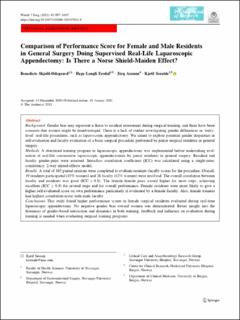| dc.contributor.author | Skjold-Ødegaard, Benedicte | |
| dc.contributor.author | Ersdal, Hege Langli | |
| dc.contributor.author | Assmus, Jörg | |
| dc.contributor.author | Søreide, Kjetil | |
| dc.date.accessioned | 2021-05-21T08:12:07Z | |
| dc.date.available | 2021-05-21T08:12:07Z | |
| dc.date.created | 2021-05-05T20:05:00Z | |
| dc.date.issued | 2021-01 | |
| dc.identifier.citation | Skjold-Ødegaard, B., Ersdal, H.L., Assmus, J. et al. Comparison of Performance Score for Female and Male Residents in General Surgery Doing Supervised Real-Life Laparoscopic Appendectomy: Is There a Norse Shield-Maiden Effect?. World Journal of Surgery, 45, pp. 997–1005 | en_US |
| dc.identifier.issn | 0364-2313 | |
| dc.identifier.uri | https://hdl.handle.net/11250/2755971 | |
| dc.description.abstract | Background
Gender bias may represent a threat to resident assessment during surgical training, and there have been concerns that women might be disadvantaged. There is a lack of studies investigating gender differences in ‘entry-level’ real-life procedures, such as laparoscopic appendectomy. We aimed to explore potential gender disparities in self-evaluation and faculty evaluation of a basic surgical procedure performed by junior surgical residents in general surgery.
Methods
A structured training program in laparoscopic appendectomy was implemented before undertaking evaluation of real-life consecutive laparoscopic appendectomies by junior residents in general surgery. Resident and faculty gender-pairs were assessed. Intraclass correlation coefficient (ICC) was calculated using a single-rater, consistency, 2-way mixed-effects model.
Results
A total of 165 paired sessions were completed to evaluate resident–faculty scores for the procedure. Overall, 19 residents participated (43% women) and 26 faculty (42% women) were involved. The overall correlation between faculty and residents was good (ICC > 0.8). The female–female pairs scored higher for most steps, achieving excellent (ICC ≥ 0.9) for several steps and for overall performance. Female residents were more likely to give a higher self-evaluated score on own performance particularly if evaluated by a female faculty. Also, female trainees had highest correlation-score with male faculty.
Conclusions
This study found higher performance scores in female surgical residents evaluated during real-time laparoscopic appendectomy. No negative gender bias toward women was demonstrated. Better insight into the dynamics of gender-based interaction and dynamics in both training, feedback and influence on evaluation during training is needed when evaluating surgical training programs. | en_US |
| dc.language.iso | eng | en_US |
| dc.publisher | Springer Nature Switzerland AG | en_US |
| dc.rights | Navngivelse 4.0 Internasjonal | * |
| dc.rights.uri | http://creativecommons.org/licenses/by/4.0/deed.no | * |
| dc.subject | kirurgi | en_US |
| dc.subject | kjønnsroller | en_US |
| dc.subject | kvinnelige kirurger | en_US |
| dc.title | Comparison of performance score for female and male residents in general surgery doing supervised real-life laparoscopic appendectomy: Is there a Norse shield-maiden effect? | en_US |
| dc.type | Peer reviewed | en_US |
| dc.type | Journal article | en_US |
| dc.description.version | publishedVersion | en_US |
| dc.subject.nsi | VDP::Medisinske Fag: 700::Klinisk medisinske fag: 750::Generell kirurgi: 780 | en_US |
| dc.subject.nsi | VDP::Samfunnsvitenskap: 200::Kvinne- og kjønnsstudier: 370 | en_US |
| dc.source.pagenumber | 997-1005 | en_US |
| dc.source.volume | 45 | en_US |
| dc.source.journal | World Journal of Surgery | en_US |
| dc.source.issue | 4 | en_US |
| dc.identifier.doi | 10.1007/s00268-020-05921-4 | |
| dc.identifier.cristin | 1908311 | |
| cristin.ispublished | true | |
| cristin.fulltext | original | |
| cristin.qualitycode | 1 | |

